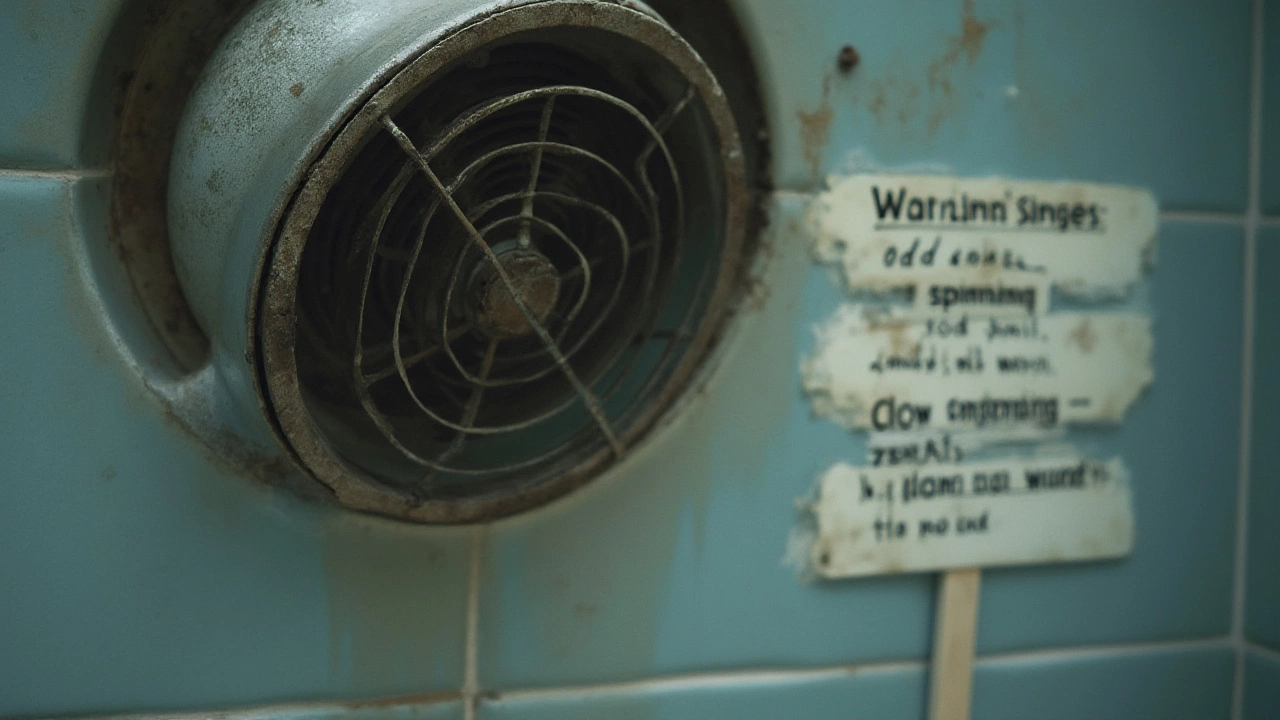If you’ve ever sat in a stuffy bathroom or cooked a big Sunday brunch only to smell onions hours later, you already know how much you rely on your extractor fan. Most of us probably don’t give it much thought until it rattles like a loose hubcap or just quits—leaving the air lingering a tad longer than we’d like. The question is: when should you actually replace an extractor fan and what’s at stake if you just leave it running until it croaks? I used to think fans just lasted forever. Truth is, they work hard behind the scenes and ignoring them can mean wasted energy, a pongy home, or even a health hazard if moisture builds up.
What’s the Real Lifespan of an Extractor Fan?
You’d expect something with just a small motor and blades to soldier on for decades—like a fabled toaster. But extractor fans, depending on use and quality, typically last between 5 to 10 years. Kitchen fans often work overtime, sucking up hot, greasy, damp air. Bathrooms are no joke either: daily showers load the fan with steam, dust, and the odd lost hair. Most manufacturers peg the lifespan at around 7 years for regular usage, which means by the time your football team wins the league again, your fan might be ready for the bench too.
Cheaper units, especially the ones builders love for new flats, may lose their gusto after just 3 to 5 years. Mid-range fans do better, and some of the beefy models with ball-bearing motors can cross the 10-year line if they’re pampered. Here’s the thing—actual lifespan isn’t just a number in a manual. It’s shaped by how much grime gets sucked in, whether the fan is cleaned or ignored, and the steadiness of your home’s voltage. Sudden power surges? Cheap plastic blades? Anything can shave years off. Plus, the UK’s classic humidity does no favours.
It’s not like you’ll wake up to a stopped fan the morning after its birthday. Instead, it’ll start making weird noises, work less efficiently, or simply run slower. In 2022, a survey of over 800 British homeowners suggested roughly half had replaced either their kitchen or bathroom extractor in the previous decade—the top reasons were noise, poor performance, or visible gunk buildup. It’s a boring purchase, but living with mould, damp, and stale air just isn’t worth it.
| Fan Location | Average Lifespan | Common Issues |
|---|---|---|
| Kitchen | 5-8 years | Sticky grease, burnt-out motor, vibration |
| Bathroom | 7-10 years | Moisture, dust buildup, noise |
| Utility Room | 6-9 years | Lack of use, bearing wear |
Telltale Signs Your Extractor Fan Needs Replacing
Most extractor fans don’t have a countdown clock, so you have to spot the warning signs yourself. One thing I’ve found: the first clue is noise. A healthy fan hums quietly in the background. When your fan starts to squeak or rattle every time you flip the switch, it’s probably telling you it’s had enough. The blades might be caked with dust, or the bearings are shot.
Performance drop is another clear signal. If moisture lingers on your bathroom mirror for ages or kitchen odours hang around after you’ve finished frying, the fan’s suction just isn’t cutting it. I know at our house in Bristol, if Lorelai spends a Sunday baking, and the kitchen still smells like cinnamon two days later, it’s time to check the extractor.
Sometimes, you’ll spot discolouration or even mould around the vent. This means humidity isn’t leaving—and that’s a damp disaster waiting to happen. In fact, more than 40% of UK homes face condensation or damp at some point, often made worse by tired or clogged extractors. Stubborn gunk buildup, yellow streaks, or strange buzzing? Don’t ignore them. Some fans even refuse to turn on, or they trip the breaker—a red flag for deeper electrical issues inside the fan. And, if your fan feels hot to the touch, it’s overheating, which can signal a dangerous risk of fire.
- Noisy or rattling when switched on
- Stubborn humidity or lingering smells
- Visible mould or black spots near the vent
- Fan blades not spinning properly or slowly
- Frequent tripping of the breaker
- A burning smell or overheating unit
If you’re unsure, a simple paper test helps: hold a small piece of tissue up to the grille when the fan is on. If it sticks, your airflow is decent; if it drops, the fan’s just spinning its wheels.

Getting the Most out of Your Extractor Fan
Here’s the thing—extractor fans are the silent heroes of clean, healthy living spaces. Yet, most people ignore them until something goes wrong. You don’t have to. Regular cleaning and a few smart habits can stretch your fan’s life by years.
First, dust and gunk. Every few months, unplug the unit (or turn off the breaker), and give the grille and blades a wipe or rinse. Too many folks are shocked to find how much dust, grease, and debris gets packed into the blades, making the fan work harder—and wear out quicker. In kitchens, a fan clogged with grease just can’t move air efficiently. Use a damp cloth, mild soap, and an old toothbrush for corners.
Check for odd smells—it shouldn’t stink. A burning aroma means the motor’s giving up. Don’t poke around electricals if you’re not comfortable—call in a pro for a check-up. Sometimes you can replace just the motor, which costs less than a new unit.
Switch fan filters if your system uses them. Old, clogged filters choke the fan and could be harbouring bacteria or mould. Set a reminder to swap them out every 6-12 months, or sooner if you cook a lot or have pets. If you use dehumidifiers, coordinate their placement so you’re not fighting your fan.
Always let the bathroom fan run for 15-20 minutes after a shower. Moisture continues to hang in the air even when you can’t see it. The same goes for the kitchen after cooking—don’t switch the fan off as soon as you’re done frying. Some new fans come with timers or humidity sensors, which can help here.
Tighten loose fixings and check for any wobble when the fan is on. Even a half-millimeter of play can stress the bearings and shorten the fan’s lifespan. It sounds a bit much, but the little stuff makes a difference.
- Clean fan grilles and blades every quarter
- Replace or wash filters twice a year
- Don’t ignore burning smells or weird sounds
- Allow the fan to run after baths or cooking
- Check mounting points for vibration
When Replacement is Better Than Repair
You might be tempted to just patch up your fan—maybe give the blades a clean and forget about it. That works for burnt toast, not so much for worn-out motors. There’s a point where repair doesn’t make sense, both for your wallet and your health. According to research by Which? magazine in 2023, the average cost to repair an extractor fan sits between £50 and £100, mainly for labour. But if your unit’s over 7 years old, or replacement parts are scarce (especially for discontinued models), a shiny new model is smarter.
Replacement lets you take advantage of new tech too. Modern extractor fans are quieter, far more energy-efficient, and come with features like humidity sensors, motion detection, or trickle vents for constant fresh air. Some models can even hook into your smartphone—though honestly, if you’re like me, you’ll just want one that clears the kitchen after you’ve burnt the garlic bread. In Bristol, where space is tight in some homes, finding a slim unit makes swapping easier.
Don’t be afraid to upgrade. Technology has come a long way since those noisy, ugly white boxes from the 1990s. For example, many new extractor fans use EC motors—these use up to 70% less power than the old shaded pole motors, saving money and the planet. UK regulations also shifted in 2020 to raise efficiency standards, so anything new is likely a greener bet.
Here’s a tip: if rewiring is needed, or insulation has changed in your loft or walls since the last install, get a professional to do the swap. It’s not worth risking a botched job for the sake of a YouTube tutorial, especially since damp and electrical wiring just don’t mix.
- Replacement is ideal after 7-10 years
- Upgrade if repairs get too frequent or noisy
- Modern units save energy and run quieter
- Watch for UK regulation updates on efficiency
- Professional installation ensures proper sealing and insulation
If you notice persistent damp on walls, rising heating bills, or allergies getting worse, don’t just blame the weather—your extractor fan could be letting you down. Take a moment to check its age, performance, and noise levels, and don’t stick with a tired unit just because it’s still spinning. Breathing cleaner air really is worth it. Your health—and maybe your next Sunday roast—will thank you for it.




